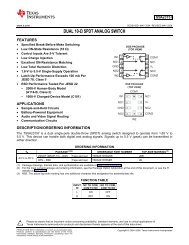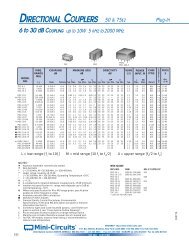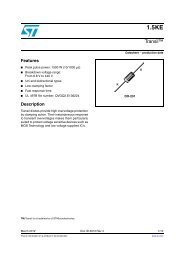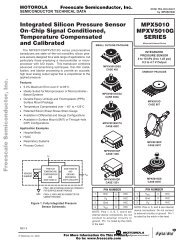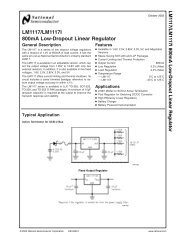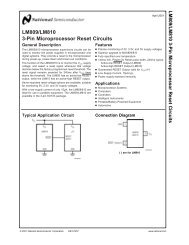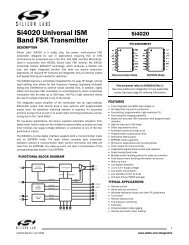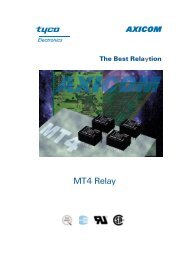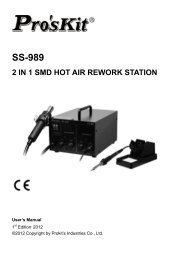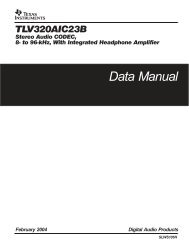XTR106: 4-20mA Current Transmitter with Bridge Excitation And ...
XTR106: 4-20mA Current Transmitter with Bridge Excitation And ...
XTR106: 4-20mA Current Transmitter with Bridge Excitation And ...
- No tags were found...
You also want an ePaper? Increase the reach of your titles
YUMPU automatically turns print PDFs into web optimized ePapers that Google loves.
PIN CONFIGURATIONTop ViewV REGV – INR GR G+V INI RETI O1234567141312111098V REF 5V REF 2.5Lin PolarityR LINV+B (Base)E (Emitter)DIP and SOICPACKAGE/ORDERING INFORMATIONFor the most current package and ordering information, seethe Package Option Addendum at the end of this data sheet.ABSOLUTE MAXIMUM RATINGS (1)Power Supply, V+ (referenced to I O pin) .......................................... 40V+ –Input Voltage, V IN , V IN (referenced to I RET pin) ......................... 0V to V+Storage Temperature Range ....................................... –55°C to +125°CLead Temperature (soldering, 10s) .............................................. +300°COutput <strong>Current</strong> Limit ............................................................... ContinuousJunction Temperature ................................................................... +165°CNOTE: (1) Stresses above these ratings may cause permanent damage.Exposure to absolute maximum conditions for extended periods may degradedevice reliability.ELECTROSTATICDISCHARGE SENSITIVITYThis integrated circuit can be damaged by ESD. Texas Instrumentsrecommends that all integrated circuits be handled <strong>with</strong>appropriate precautions. Failure to observe proper handlingand installation procedures can cause damage.ESD damage can range from subtle performance degradationto complete device failure. Precision integrated circuitsmay be more susceptible to damage because very smallparametric changes could cause the device not to meet itspublished specifications.<strong>XTR106</strong> 3SBOS092Awww.ti.com
FUNCTIONAL DIAGRAMLinPolarityV REG12R LINV+1111014V REF 513V REF 2.5+ 5V IN4R GREFAmpBandgapV REF100µALinAmp<strong>Current</strong>DirectionSwitch5.1V975Ω25ΩB93EV IN–2I = 100µA + V INR G867I O = 4mA + V IN • ( )40R GI RET4www.ti.com<strong>XTR106</strong>SBOS092A
TYPICAL PERFORMANCE CURVESAt T A = +25°C, V+ = 24V, unless otherwise noted.Transconductance (20 log mA/V)605040302010TRANSCONDUCTANCE vs FREQUENCYC OUT = 0.01µFR G = 50ΩC OUT = 0.033µFC OUT connectedbetween V+ and I OR G = 1kΩR L = 250Ω4mA/div<strong>20mA</strong>4mAR G = 1kΩSTEP RESPONSEC OUT = 0.01µFR G = 50Ω0100 1k 10k 100k 1MFrequency (Hz)50µs/divCommon-Mode Rejection (dB)110100908070605040COMMON-MODE REJECTION vs FREQUENCYR G = 1kΩR G = 50ΩPower Supply Rejection (dB)16014012010080604020POWER SUPPLY REJECTION vs FREQUENCYC OUT = 0R G = 50ΩR G = 1kΩ3010 100 1k 10k 100k 1MFrequency (Hz)010 100 1k 10k 100k 1MFrequency (Hz)Percent of Units (%)9080706050403020INPUT OFFSET VOLTAGE DRIFTPRODUCTION DISTRIBUTIONTypical productiondistribution ofpackaged units.∆ V OS (µV)1.51.00.50–0.5–1.0–1.5INPUT OFFSET VOLTAGE CHANGEvs V REG and V REF CURRENTSV OS vs I REGV OS vs I REF10–2.0000.250.50.751.01.251.51.752.02.252.52.753.0–2.5–1.0 –0.5 0 0.5 1.0 1.5 2.0 2.5<strong>Current</strong> (mA)Offset Voltage Drift (µV/°C)<strong>XTR106</strong> 5SBOS092Awww.ti.com
TYPICAL PERFORMANCE CURVES (CONT)At T A = +25°C, V+ = 24V, unless otherwise noted.UNDER-SCALE CURRENT vs TEMPERATUREUNDER-SCALE CURRENT vs I REF + I REG2.54.03.5Under-Scale <strong>Current</strong> (mA)2.01.51.00.5V+ = 7.5V to 36VUnder-Scale <strong>Current</strong> (mA)3.02.52.01.51.00.5T A = –55°CT A= +125°CT A = +25°C0–75 –50 –25 0 25 50 75 10012500 0.5 1.0 1.5 2.0 2.5Temperature (°C)I REF + I REG (mA)30OVER-SCALE CURRENT vs TEMPERATURE3.0ZERO OUTPUT ERRORvs V REFand V REGCURRENTS29With External Transistor2.5Over-Scale <strong>Current</strong> (mA)28272625V+ = 36VV+ = 24VV+ = 7.5VZero Output Error (µA)2.01.51.00.50–0.5I ZERO Error vs I REGI ZERO Error vs I REF24–75 –50 –25 0 25 50 75 100125–1.0–1 –0.5 0 0.5 1.0 1.5 2.02.5Temperature (°C)<strong>Current</strong> (mA)Zero Output <strong>Current</strong> Error (µA)420–2–4–6–8–10ZERO OUTPUT CURRENT ERRORvs TEMPERATUREPercent of Units (%)70605040302010ZERO OUTPUT DRIFTPRODUCTION DISTRIBUTIONTypical productiondistribution ofpackaged units.–12–75 –50 –25 0 25 50 75 1001250Temperature (°C)00.050.10.150.20.250.30.350.40.450.50.550.60.650.70.750.80.850.9Zero Output Drift (µA/°C)6www.ti.com<strong>XTR106</strong>SBOS092A
TYPICAL PERFORMANCE CURVES (CONT)At T A = +25°C, V+ = 24V, unless otherwise noted.10kINPUT VOLTAGE, INPUT CURRENT, and ZEROOUTPUT CURRENT NOISE DENSITY vs FREQUENCY10k10INPUT BIAS and OFFSET CURRENTvs TEMPERATUREInput Voltage Noise (nV/√Hz)1k10010Zero Output NoiseInput <strong>Current</strong> NoiseInput Voltage Noise1 10 100 1k 10kFrequency (Hz)1k10010100kInput <strong>Current</strong> Noise (fA/√Hz)Zero Output <strong>Current</strong> Noise (pA/√Hz)Input Bias and Offset <strong>Current</strong> (nA)86I B42I OS0–2–75 –50 –25 0 25 50 75 100 125Temperature (°C)5.6V REG OUTPUT VOLTAGE vs V REG OUTPUT CURRENTREFERENCE TRANSIENT RESPONSEV REF = 5VV REG Output <strong>Current</strong> (V)5.55.45.35.25.15.04.9T A= +25°C, –55°CT A = +125°C500µA/div 50mV/divReferenceOutput1mA04.8–1.0 –0.5 0 0.5 1.0 1.5 2.0 2.5V REGOutput <strong>Current</strong> (mA)10µs/div5.008V REF 5 vs V REG OUTPUT CURRENT120REFERENCE AC LINE REJECTION vs FREQUENCYV REF 5 (V)5.004T A = +25°C5.0004.996T A = +125°C4.992T A = –55°C4.988–1.0 –0.5 0 0.5 1.0 1.5 2.0 2.5V REG <strong>Current</strong> (mA)Line Rejection (dB)100V80REF 2.560V REF 54020010 100 1k 10k 100k 1MFrequency (Hz)<strong>XTR106</strong> 7SBOS092Awww.ti.com
TYPICAL PERFORMANCE CURVES (CONT)At T A = +25°C, V+ = 24V, unless otherwise noted.Percent of Units (%)403530252015105REFERENCE VOLTAGE DRIFTPRODUCTION DISTRIBUTIONTypical productiondistribution ofpackaged units.Reference Voltage Deviation (%)0.10–0.1–0.2–0.3–0.4REFERENCE VOLTAGE DEVIATIONvs TEMPERATUREV REF= 2.5VV REF= 5V08101214161820222426283032343638400246Reference Voltage Drift (ppm/°C)–0.5–75 –50 –25 0 25 50 75 100 125Temperature (°C)8www.ti.com<strong>XTR106</strong>SBOS092A
APPLICATIONS INFORMATIONFigure 1 shows the basic connection diagram for the <strong>XTR106</strong>.The loop power supply, V PS , provides power for all circuitry.Output loop current is measured as a voltage across the seriesload resistor, R L . A 0.01µF to 0.03µF supply bypass capacitorconnected between V+ and I O is recommended. For applicationswhere fault and/or overload conditions might saturatethe inputs, a 0.03µF capacitor is recommended.A 2.5V or 5V reference is available to excite a bridge sensor.For 5V excitation, pin 14 (V REF 5) should be connected to thebridge as shown in Figure 1. For 2.5V excitation, connectpin 13 (V REF 2.5) to pin 14 as shown in Figure 3b. The outputterminals of the bridge are connected to the instrumentationamplifier inputs, V IN and V IN . A 0.01µF capacitor is shown+ –connected between the inputs and is recommended for highimpedance bridges (> 10kΩ). The resistor R G sets the gainof the instrumentation amplifier as required by the full-scalebridge voltage, V FS .Lin Polarity and R LIN provide second-order linearizationcorrection to the bridge, achieving up to a 20:1 improvementin linearity. Connections to Lin Polarity (pin 12) determinethe polarity of nonlinearity correction and should be connectedeither to I RET or V REG . Lin Polarity should be connectedto V REG even if linearity correction is not desired.R LIN is chosen according to the equation in Figure 1 and isdependent on K LIN (linearization constant) and the bridge’snonlinearity relative to V FS (see “Linearization” section).The transfer function for the complete current transmitter is:I O = 4mA + V IN • (40/R G ) (1)V IN in Volts, R G in Ohmswhere V IN is the differential input voltage. As evident fromthe transfer function, if no R G is used (R G = ∞), the gain iszero and the output is simply the <strong>XTR106</strong>’s zero current.A negative input voltage, V IN , will cause the output currentto be less than 4mA. Increasingly negative V IN will cause theoutput current to limit at approximately 1.6mA. If current isbeing sourced from the reference and/or V REG , the currentlimit value may increase. Refer to the Typical PerformanceCurves, “Under-Scale <strong>Current</strong> vs I REF + I REG ” and “Under-Scale <strong>Current</strong> vs Temperature.”Increasingly positive input voltage (greater than the fullscaleinput, V FS ) will produce increasing output currentaccording to the transfer function, up to the output currentlimit of approximately 28mA. Refer to the Typical PerformanceCurve, “Over-Scale <strong>Current</strong> vs Temperature.”The I RET pin is the return path for all current from thereferences and V REG . I RET also serves as a local ground andis the reference point for V REG and the on-board voltagereferences. The I RET pin allows any current used in externalcircuitry to be sensed by the <strong>XTR106</strong> and to be included inthe output current <strong>with</strong>out causing error. The input voltagerange of the <strong>XTR106</strong> is referred to this pin.For 2.5V excitation, connectpin 13 to pin 14V REF 55V REF 2.5V REGR LIN(3)141311+ 1V INR LIN 10 VREGV+7.5V to 36VPossible choices for Q 1 (see text).TYPE2N4922TIP29CTIP31CPACKAGETO-225TO-220TO-220R 2(5)R 1(5)<strong>Bridge</strong>Sensor5V+ R B –C IN0.01µF (2)4(4)R G32R GR G<strong>XTR106</strong>Lin (1)–V PolarityINI RET12BI OE798Q 1C OUT0.01µFI O4-20 mAV OR L+V PS–6I = 4mA + V IN • (40O)V (1)R GREGorNOTES:(1) Connect Lin Polarity (pin 12) to I RET (pin 6) to correct for positivebridge nonlinearity or connect to V REG (pin 1) for negative bridgenonlinearity. The R LIN pin and Lin Polarity pin must be connected toV REG if linearity correction is not desired. Refer to “Linearization”section and Figure 3.(2) Recommended for bridge impedances > 10kΩ4B( 3) R LIN = K LIN •(K LIN in Ω)1 – 2B(4) R G = (V FS /400µA) •1 + 2B1 – 2B(V FS in V)where K LIN = 9.905kΩ for 2.5V referenceK LIN = 6.645kΩ for 5V referenceB is the bridge nonlinearity relative to V FSV FS is the full-scale input voltage(5) R 1 and R 2 form bridge trim circuit to compensate for the initialaccuracy of the bridge. See “<strong>Bridge</strong> Balance” text.FIGURE 1. Basic <strong>Bridge</strong> Measurement Circuit <strong>with</strong> Linearization.<strong>XTR106</strong> 9SBOS092Awww.ti.com
EXTERNAL TRANSISTORExternal pass transistor, Q 1 , conducts the majority of thesignal-dependent 4-<strong>20mA</strong> loop current. Using an externaltransistor isolates the majority of the power dissipation fromthe precision input and reference circuitry of the <strong>XTR106</strong>,maintaining excellent accuracy.Since the external transistor is inside a feedback loop itscharacteristics are not critical. Requirements are: V CEO = 45Vmin, β = 40 min and P D = 800mW. Power dissipation requirementsmay be lower if the loop power supply voltage is lessthan 36V. Some possible choices for Q 1 are listed in Figure 1.The <strong>XTR106</strong> can be operated <strong>with</strong>out an external passtransistor. Accuracy, however, will be somewhat degradeddue to the internal power dissipation. Operation <strong>with</strong>out Q 1is not recommended for extended temperature ranges. Aresistor (R = 3.3kΩ) connected between the I RET pin and theE (emitter) pin may be needed for operation below 0°C<strong>with</strong>out Q 1 to guarantee the full <strong>20mA</strong> full-scale output,especially <strong>with</strong> V+ near 7.5V.V+E<strong>XTR106</strong>I O7I RET6R Q = 3.3kΩ1080.01µFFor operation <strong>with</strong>out externaltransistor, connect a 3.3kΩresistor between pin 6 andpin 8. See text for discussionof performance.FIGURE 2. Operation <strong>with</strong>out External Transistor.LOOP POWER SUPPLYThe voltage applied to the <strong>XTR106</strong>, V+, is measured <strong>with</strong>respect to the I O connection, pin 7. V+ can range from 7.5Vto 36V. The loop supply voltage, V PS , will differ from thevoltage applied to the <strong>XTR106</strong> according to the voltage dropon the current sensing resistor, R L (plus any other voltagedrop in the line).If a low loop supply voltage is used, R L (including the loopwiring resistance) must be made a relatively low value toassure that V+ remains 7.5V or greater for the maximumloop current of <strong>20mA</strong>:(2)R L max =⎛ (V+)–7.5V ⎞⎝ <strong>20mA</strong> ⎠ –R WIRINGIt is recommended to design for V+ equal or greater than7.5V <strong>with</strong> loop currents up to 30mA to allow for out-ofrangeinput conditions. V+ must be at least 8V if 5V sensorexcitation is used and if correcting for bridge nonlinearitygreater than +3%.The low operating voltage (7.5V) of the <strong>XTR106</strong> allowsoperation directly from personal computer power supplies(12V ±5%). When used <strong>with</strong> the RCV420 <strong>Current</strong> LoopReceiver (Figure 8), load resistor voltage drop is limited to 3V.BRIDGE BALANCEFigure 1 shows a bridge trim circuit (R 1 , R 2 ). This adjustmentcan be used to compensate for the initial accuracy ofthe bridge and/or to trim the offset voltage of the <strong>XTR106</strong>.The values of R 1 and R 2 depend on the impedance of thebridge, and the trim range required. This trim circuit placesan additional load on the V REF output. Be sure the additionalload on V REF does not affect zero output. See the TypicalPerformance Curve, “Under-Scale <strong>Current</strong> vs I REF + I REG .”The effective load of the trim circuit is nearly equal to R 2 .An approximate value for R 1 can be calculated:R 1 ≈ 5V • R (3)B4 • V TRIMwhere, R B is the resistance of the bridge.V TRIM is the desired ±voltage trim range (in V).Make R 2 equal or lower in value to R 1 .LINEARIZATIONMany bridge sensors are inherently nonlinear. With theaddition of one external resistor, it is possible to compensatefor parabolic nonlinearity resulting in up to 20:1 improvementover an uncompensated bridge output.Linearity correction is accomplished by varying the bridgeexcitation voltage. Signal-dependent variation of the bridgeexcitation voltage adds a second-order term to the overalltransfer function (including the bridge). This can be tailoredto correct for bridge sensor nonlinearity.Either positive or negative bridge non-linearity errors can becompensated by proper connection of the Lin Polarity pin.To correct for positive bridge nonlinearity (upward bowing),Lin Polarity (pin 12) should be connected to I RET (pin 6) asshown in Figure 3a. This causes V REF to increase <strong>with</strong> bridgeoutput which compensates for a positive bow in the bridgeresponse. To correct negative nonlinearity (downward bowing),connect Lin Polarity to V REG (pin 1) as shown in Figure3b. This causes V REF to decrease <strong>with</strong> bridge output. The LinPolarity pin is a high impedance node.If no linearity correction is desired, both the R LIN and LinPolarity pins should be connected to V REG (Figure 3c). Thisresults in a constant reference voltage independent of inputsignal. R LIN or Lin Polarity pins should not be left openor connected to another potential.R LIN is the external linearization resistor and is connectedbetween pin 11 and pin 1 (V REG ) as shown in Figures 3a and3b. To determine the value of R LIN , the nonlinearity of thebridge sensor <strong>with</strong> constant excitation voltage must beknown. The <strong>XTR106</strong>’s linearity circuitry can only compensatefor the parabolic-shaped portions of a sensor’snonlinearity. Optimum correction occurs when maximumdeviation from linear output occurs at mid-scale (see Figure4). Sensors <strong>with</strong> nonlinearity curves similar to that shown in10www.ti.com<strong>XTR106</strong>SBOS092A
Figure 4, but not peaking exactly at mid-scale can besubstantially improved. A sensor <strong>with</strong> a “S-shaped”nonlinearity curve (equal positive and negative nonlinearity)cannot be improved <strong>with</strong> the <strong>XTR106</strong>’s correction circuitry.The value of R LIN is chosen according to Equation 4 shownin Figure 3. R LIN is dependent on a linearization factor,K LIN , which differs for the 2.5V reference and 5V reference.The sensor’s nonlinearity term, B (relative to full scale), ispositive or negative depending on the direction of the bow.A maximum ±5% non-linearity can be corrected when the5V reference is used. Sensor nonlinearity of +5%/–2.5% canbe corrected <strong>with</strong> 2.5V excitation. The trim circuit shown inFigure 3d can be used for bridges <strong>with</strong> unknown bridgenonlinearity polarity.Gain is affected by the varying excitation voltage used tocorrect bridge nonlinearity. The corrected value of the gainresistor is calculated from Equation 5 given in Figure 3.V REGV REF 5V REF 2.5<strong>XTR106</strong>14R13LIN51+115V 4R 1R 2 + –R G <strong>XTR106</strong>V REF 2.532–6I RET3a. Connection for Positive <strong>Bridge</strong> Nonlinearity, V REF = 5V12 LinPolarityV REF 514R13LIN51+112.5V 4R 1R 2 + –R G <strong>XTR106</strong>32I RET3b. Connection for Negative <strong>Bridge</strong> Nonlinearity, V REF = 2.5VV REF 5–6V REG12 LinPolarity1413 R LIN51+115V 4R 1R 2 + –R G <strong>XTR106</strong>3V REF 2.5V REGR LIN =I RET6LinPolarityR X R Y100kΩ 15kΩOpen R X for negative bridge nonlinearityOpen R Y for positive bridge nonlinearity4BR LIN = K LIN •1– 2B(9905Ω)(4)(–0.025)1 – (2) (–0.025)12V REG3d. On-Board Resistor Circuit for Unknown <strong>Bridge</strong> Nonlinearity PolarityEQUATIONSLinearization Resistor:Gain-Set Resistor:R G =V REF (Adj)V FS400µA • 1 + 2B1 – 2B= V REF (Initial) • 1 + 2B1 – 2B= 943Ω1(in Ω)(in Ω)Adjusted <strong>Excitation</strong> Voltage at Full-Scale Output:(in V)where, K LIN is the linearization factor (in Ω)K LIN = 9905Ω for the 2.5V referenceK LIN = 6645Ω for the 5V referenceB is the sensor nonlinearity relative to V FS(for –2.5% nonlinearity, B = –0.025)V FS is the full-scale bridge output <strong>with</strong>outlinearization (in V)Example:Calculate R LIN and the resulting R G for a bridge sensor <strong>with</strong>2.5% downward bow nonlinearity relative to V FS and determineif the input common-mode range is valid.V REF = 2.5V and V FS = 50mVFor a 2.5% downward bow, B = –0.025(Lin Polarity pin connected to V REG )For V REF = 2.5V, K LIN = 9905Ω(4)(5)(6)2I RET–612 LinPolarityR G = 0.05V 1 + (2) (–0.025)•400µA 1 – (2) (–0.025) = 113ΩV CM = V REF (Adj)2= 1 2• 2.5V •1 + (2) (–0.025)1 – (2) (–0.025) = 1.13 V3c. Connection if no linearity correction is desired, V REF = 5Vwhich falls <strong>with</strong>in the 1.1V to 3.5V input common-mode range.FIGURE 3. Connections and Equations to Correct Positive and Negative <strong>Bridge</strong> Nonlinearity.<strong>XTR106</strong> 11SBOS092Awww.ti.com
When using linearity correction, care should be taken toinsure that the sensor’s output common-mode voltage remains<strong>with</strong>in the <strong>XTR106</strong>’s allowable input range of 1.1V to3.5V. Equation 6 in Figure 3 can be used to calculate the<strong>XTR106</strong>’s new excitation voltage. The common-mode voltageof the bridge output is simply half this value if nocommon-mode resistor is used (refer to the example inFigure 3). Exceeding the common-mode range may yieldunpredicatable results.For high precision applications (errors < 1%), a two-stepcalibration process can be employed. First, the nonlinearityof the sensor bridge is measured <strong>with</strong> the initial gain resistorand R LIN = 0 (R LIN pin connected directly to V REG ). Usingthe resulting sensor nonlinearity, B, values for R G and R LINare calculated using Equations 4 and 5 from Figure 3. Asecond calibration measurement is then taken to adjust R G toaccount for the offsets and mismatches in the linearization.UNDER-SCALE CURRENTThe total current being drawn from the V REF and V REGvoltage sources, as well as temperature, affect the <strong>XTR106</strong>’sunder-scale current value (see the Typical PerformanceCurve, “Under-Scale <strong>Current</strong> vs I REF + I REG ). This should beconsidered when choosing the bridge resistance and excitationvoltage, especially for transducers operating over awide temperature range (see the Typical Performance Curve,“Under-Scale <strong>Current</strong> vs Temperature”).LOW IMPEDANCE BRIDGESThe <strong>XTR106</strong>’s two available excitation voltages (2.5V and5V) allow the use of a wide variety of bridge values. <strong>Bridge</strong>impedances as low as 1kΩ can be used <strong>with</strong>out any additionalcircuitry. Lower impedance bridges can be used <strong>with</strong>the <strong>XTR106</strong> by adding a series resistance to limit excitationcurrent to ≤ 2.5mA (Figure 5). Resistance should be added10BRIDGE TRANSDUCER TRANSFER FUNCTIONWITH PARABOLIC NONLINEARITY3NONLINEARITY vs STIMULUS9<strong>Bridge</strong> Output (mV)8765432100Positive NonlinearityB = +0.025B = –0.019Negative NonlinearityLinear Response0.1 0.2 0.3 0.4 0.5 0.6 0.7 0.8 0.9 1Nonlinearity (% of Full Scale)210–1–2–30Positive NonlinearityB = +0.025Negative NonlinearityB = –0.0190.1 0.2 0.3 0.4 0.5 0.6 0.7 0.8 0.9 1Normalized StimulusNormalized StimulusFIGURE 4. Parabolic Nonlinearity.700µA at 5VV REF 5I TOTAL = 0.7mA + 1.6mA ≤ 2.5mAI REG ≈ 1.6mAV REF 2.5V REG3.4kΩ5V1/2OPA22771kΩ54V + IN14131R LIN1110V+1N4148350Ω10kΩR G3.4kΩ412Ω1/2OPA227710kΩR G125Ω32R GV – IN<strong>XTR106</strong>B9E8Lin I OPolarity7I RET 1260.01µFI O = 4-<strong>20mA</strong><strong>Bridge</strong> excitationvoltage = 0.245VApprox. x50amplifierShown connected to correct positivebridge nonlinearity. For negative bridgenonlinearity, see Figure 3b.FIGURE 5. 350Ω <strong>Bridge</strong> <strong>with</strong> x50 Preamplifier.12www.ti.com<strong>XTR106</strong>SBOS092A
to the upper and lower sides of the bridge to keep the bridgeoutput <strong>with</strong>in the 1.1V to 3.5V common-mode input range.<strong>Bridge</strong> output is reduced so a preamplifier as shown may beneeded to reduce offset voltage and drift.OTHER SENSOR TYPESThe <strong>XTR106</strong> can be used <strong>with</strong> a wide variety of inputs. Itshigh input impedance instrumentation amplifier is versatileand can be configured for differential input voltages frommillivolts to a maximum of 2.4V full scale. The linear rangeof the inputs is from 1.1V to 3.5V, referenced to the I RETterminal, pin 6. The linearization feature of the <strong>XTR106</strong> canbe used <strong>with</strong> any sensor whose output is ratiometric <strong>with</strong> anexcitation voltage.ERROR ANALYSISTable I shows how to calculate the effect various errorsources have on circuit accuracy. A sample error calculationfor a typical bridge sensor measurement circuit is shown(5kΩ bridge, V REF = 5V, V FS = 50mV) is provided. Theresults reveal the <strong>XTR106</strong>’s excellent accuracy, in this case1.2% unadjusted. Adjusting gain and offset errors improvescircuit accuracy to 0.33%. Note that these are worst-caseerrors; guaranteed maximum values were used in the calculationsand all errors were assumed to be positive (additive).The <strong>XTR106</strong> achieves performance which is difficult toobtain <strong>with</strong> discrete circuitry and requires less board space.SAMPLE ERROR CALCULATION<strong>Bridge</strong> Impedance (R B ) 5kΩ Full Scale Input (V FS ) 50mVAmbient Temperature Range (∆T A ) 20°C <strong>Excitation</strong> Voltage (V REF ) 5VSupply Voltage Change (∆V+) 5V Common-Mode Voltage Change (∆CM) 25mV (= V FS /2)ERRORSAMPLE(ppm of Full Scale)ERROR SOURCE ERROR EQUATION ERROR CALCULATION UNADJ ADJUSTINPUTInput Offset Voltage V OS /V FS • 10 6 200µV/50mV • 10 6 2000 0vs Common-Mode CMRR • ∆CM/V FS • 10 6 50µV/V • 0.025V/50mV • 10 6 25 25vs Power Supply (V OS vs V+) • (∆V+)/V FS • 10 6 3µV/V • 5V/50mV • 10 6 300 300Input Bias <strong>Current</strong> CMRR • I B • (R B /2)/ V FS • 10 6 50µV/V • 25nA • 2.5kΩ/50mV • 10 6 0.1 0Input Offset <strong>Current</strong> I OS • R B /V FS • 10 6 3nA • 5kΩ/50mV • 10 6 300 0Total Input Error 2625 325EXCITATIONVoltage Reference Accuracy V REF Accuracy (%)/100% • 10 6 0.25%/100% • 10 6 2500 0vs Supply (V REF vs V+) • (∆V+) • (V FS /V REF ) 20ppm/V • 5V (50mV/5V) 1 1Total <strong>Excitation</strong> Error 2501 1GAINSpan Span Error (%)/100% • 10 6 0.2%/100% • 10 6 2000 0Nonlinearity Nonlinearity (%)/100% • 10 6 0.01%/100% • 10 6 100 100Total Gain Error 2100 100OUTPUTZero Output | I ZERO – 4mA | /16000µA • 10 6 25µA/16000µA • 10 6 1563 0vs Supply (I ZERO vs V+) • (∆V+)/16000µA • 10 6 0.2µA/V • 5V/16000µA • 10 6 62.5 62.5Total Output Error 1626 63DRIFT (∆T A = 20°C)Input Offset Voltage Drift • ∆T A /(V FS ) • 10 6 1.5µV/°C • 20°C / (50mV) • 10 6 600 600Input Offset <strong>Current</strong> (typical) Drift • ∆T A • R B /(V FS ) • 10 6 5pA / °C • 20°C • 5kΩ/ (50mV) • 10 6 10 10Voltage Refrence Accuracy 35ppm/°C • 20°C 700 700Span 225ppm/°C • 20°C 500 500Zero Output Drift • ∆T A / 16000µA • 10 6 0.9µA/°C • 20°C / 16000µA • 10 6 1125 1125Total Drift Error 2936 2936NOISE (0.1Hz to 10Hz, typ)Input Offset Voltage V n (p-p)/ V FS • 10 6 0.6µV / 50mV • 10 6 12 12Zero Output I ZERO Noise / 16000µA • 10 6 0.035µA / 16000µA • 10 6 2.2 2.2Thermal R B Noise [√ 2 • √ (R B /2)/1kΩ • 4nV / √ Hz • √ 10Hz ] / V FS • 10 6 [√ 2 • √ 2.5kΩ /1kΩ • 4nV/ √ Hz • √ 10Hz ] / 50mV • 10 6 0.6 0.6Input <strong>Current</strong> Noise (i n • 40.8 • √2 • R B /2)/V FS • 10 6 (200fA/√Hz • 40.8 • √2 • 2.5kΩ)/50mV• 10 6 0.6 0.6Total Noise Error 15 15NOTE (1): All errors are min/max and referred to input, unless otherwise stated.TOTAL ERROR: 11803 33401.18% 0.33%TABLE I. Error Calculation.<strong>XTR106</strong> 13SBOS092Awww.ti.com
REVERSE-VOLTAGE PROTECTIONThe <strong>XTR106</strong>’s low compliance rating (7.5V) permits theuse of various voltage protection methods <strong>with</strong>out compromisingoperating range. Figure 6 shows a diode bridgecircuit which allows normal operation even when the voltageconnection lines are reversed. The bridge causes a twodiode drop (approximately 1.4V) loss in loop supply voltage.This results in a compliance voltage of approximately9V—satisfactory for most applications. A diode can beinserted in series <strong>with</strong> the loop supply voltage and the V+pin as shown in Figure 8 to protect against reverse outputconnection lines <strong>with</strong> only a 0.7V loss in loop supplyvoltage.OVER-VOLTAGE SURGE PROTECTIONRemote connections to current transmitters can sometimes besubjected to voltage surges. It is prudent to limit the maximumsurge voltage applied to the <strong>XTR106</strong> to as low as practical.Various zener diode and surge clamping diodes are speciallydesigned for this purpose. Select a clamp diode <strong>with</strong> as low avoltage rating as possible for best protection. For example, a36V protection diode will assure proper transmitter operationat normal loop voltages, yet will provide an appropriate levelof protection against voltage surges. Characterization tests onthree production lots showed no damage to the <strong>XTR106</strong> <strong>with</strong>loop supply voltages up to 65V.Most surge protection zener diodes have a diode characteristicin the forward direction that will conduct excessivecurrent, possibly damaging receiving-side circuitry if theloop connections are reversed. If a surge protection diode isused, a series diode or diode bridge should be used forprotection against reversed connections.RADIO FREQUENCY INTERFERENCEThe long wire lengths of current loops invite radio frequencyinterference. RF can be rectified by the sensitiveinput circuitry of the <strong>XTR106</strong> causing errors. This generallyappears as an unstable output current that varies <strong>with</strong> theposition of loop supply or input wiring.If the bridge sensor is remotely located, the interference mayenter at the input terminals. For integrated transmitter assemblies<strong>with</strong> short connection to the sensor, the interferencemore likely comes from the current loop connections.Bypass capacitors on the input reduce or eliminate this inputinterference. Connect these bypass capacitors to the I RETterminal as shown in Figure 6. Although the dc voltage atthe I RET terminal is not equal to 0V (at the loop supply, V PS )this circuit point can be considered the transmitter’s “ground.”The 0.01µF capacitor connected between V+ and I O mayhelp minimize output interference.V REF 5V REF 2.55V54V IN+R G1413V+10Maximum V PS must beless than minimumvoltage rating of zenerdiode.+ R B –R G<strong>XTR106</strong>Q 10.01µFD 1(1)1N4148Diodes<strong>Bridge</strong>Sensor0.01µF0.01µF32R G–V INI RET6I OEB 9 87The diode bridge causesa 1.4V loss in loop supplyvoltage.R LV PSNOTE: (1) Zener Diode 36V: 1N4753A or MotorolaP6KE39A. Use lower voltage zener diodes <strong>with</strong> looppower supply voltages less than 30V for increasedprotection. See “Over-Voltage Surge Protection.”FIGURE 6. Reverse Voltage Operation and Over-Voltage Surge Protection.14www.ti.com<strong>XTR106</strong>SBOS092A
V REF 50.01µFSee ISO124 data sheetif isolation is needed.6kΩ4.8kΩ1MΩV REF 2.5IsothermalBlock20kΩOPA2775V IN+141311R 1LIN 10V REG V+7.5V to 36VType K1N414850Ω5.2kΩ100Ω1MΩ (1)2kΩR G1kΩ432R GR GV IN–I RET<strong>XTR106</strong>9BQ 1C OUT0.01µFE8Lin I OPolarity 7126I O = 4mA + V IN • (40)R GV REG (pin 1)I O4-20 mAV OR L+V PS–NOTE: (1) For burn-out indication.0.01µFFIGURE 7. Thermocouple Low Offset, Low Drift Loop Measurement <strong>with</strong> Diode Cold-Junction Compensation.<strong>Bridge</strong>Sensor2.5V– +R BR GV REF 55432V REF 2.5V IN+14V+R G<strong>XTR106</strong> BR G–V INI RET6V REG13 R LIN11110LinPolarity12I OE7981N4148I O = 4-<strong>20mA</strong>0.01µF+12V1µFSee ISO124 data sheetif isolation is needed.1610113 1215RCV42014213541µFV O = 0V to 5VNOTE: Lin Polarity shown connected to correct positive bridgenonlinearity. See Figure 3b to correct negative bridge nonlinearity.–12VFIGURE 8. ±12V-Powered <strong>Transmitter</strong>/Receiver Loop.<strong>XTR106</strong> 15SBOS092Awww.ti.com
PACKAGE OPTION ADDENDUMwww.ti.com11-Mar-2005PACKAGING INFORMATIONOrderable Device Status (1) PackageTypePackageDrawingPins PackageQty<strong>XTR106</strong>P ACTIVE PDIP N 14 25 Pb-Free(RoHS)<strong>XTR106</strong>PA ACTIVE PDIP N 14 25 Pb-Free(RoHS)Eco Plan (2) Lead/Ball Finish MSL Peak Temp (3)Call TICall TI<strong>XTR106</strong>U ACTIVE SOIC D 14 1 None Call TI Call TI<strong>XTR106</strong>U/2K5 ACTIVE SOIC D 14 2500 None Call TI Call TI<strong>XTR106</strong>UA ACTIVE SOIC D 14 58 None Call TI Call TI<strong>XTR106</strong>UA/2K5 ACTIVE SOIC D 14 2500 None Call TI Call TILevel-NC-NC-NCLevel-NC-NC-NC(1) The marketing status values are defined as follows:ACTIVE: Product device recommended for new designs.LIFEBUY: TI has announced that the device will be discontinued, and a lifetime-buy period is in effect.NRND: Not recommended for new designs. Device is in production to support existing customers, but TI does not recommend using this part ina new design.PREVIEW: Device has been announced but is not in production. Samples may or may not be available.OBSOLETE: TI has discontinued the production of the device.(2) Eco Plan - May not be currently available - please check http://www.ti.com/productcontent for the latest availability information and additionalproduct content details.None: Not yet available Lead (Pb-Free).Pb-Free (RoHS): TI's terms "Lead-Free" or "Pb-Free" mean semiconductor products that are compatible <strong>with</strong> the current RoHS requirementsfor all 6 substances, including the requirement that lead not exceed 0.1% by weight in homogeneous materials. Where designed to be solderedat high temperatures, TI Pb-Free products are suitable for use in specified lead-free processes.Green (RoHS & no Sb/Br): TI defines "Green" to mean "Pb-Free" and in addition, uses package materials that do not contain halogens,including bromine (Br) or antimony (Sb) above 0.1% of total product weight.(3)MSL, Peak Temp. -- The Moisture Sensitivity Level rating according to the JEDECindustry standard classifications, and peak soldertemperature.Important Information and Disclaimer:The information provided on this page represents TI's knowledge and belief as of the date that it isprovided. TI bases its knowledge and belief on information provided by third parties, and makes no representation or warranty as to theaccuracy of such information. Efforts are underway to better integrate information from third parties. TI has taken and continues to takereasonable steps to provide representative and accurate information but may not have conducted destructive testing or chemical analysis onincoming materials and chemicals. TI and TI suppliers consider certain information to be proprietary, and thus CAS numbers and other limitedinformation may not be available for release.In no event shall TI's liability arising out of such information exceed the total purchase price of the TI part(s) at issue in this document sold by TIto Customer on an annual basis.Addendum-Page 1
IMPORTANT NOTICETexas Instruments Incorporated and its subsidiaries (TI) reserve the right to make corrections, modifications,enhancements, improvements, and other changes to its products and services at any time and to discontinueany product or service <strong>with</strong>out notice. Customers should obtain the latest relevant information before placingorders and should verify that such information is current and complete. All products are sold subject to TI’s termsand conditions of sale supplied at the time of order acknowledgment.TI warrants performance of its hardware products to the specifications applicable at the time of sale inaccordance <strong>with</strong> TI’s standard warranty. Testing and other quality control techniques are used to the extent TIdeems necessary to support this warranty. Except where mandated by government requirements, testing of allparameters of each product is not necessarily performed.TI assumes no liability for applications assistance or customer product design. Customers are responsible fortheir products and applications using TI components. To minimize the risks associated <strong>with</strong> customer productsand applications, customers should provide adequate design and operating safeguards.TI does not warrant or represent that any license, either express or implied, is granted under any TI patent right,copyright, mask work right, or other TI intellectual property right relating to any combination, machine, or processin which TI products or services are used. Information published by TI regarding third-party products or servicesdoes not constitute a license from TI to use such products or services or a warranty or endorsement thereof.Use of such information may require a license from a third party under the patents or other intellectual propertyof the third party, or a license from TI under the patents or other intellectual property of TI.Reproduction of information in TI data books or data sheets is permissible only if reproduction is <strong>with</strong>outalteration and is accompanied by all associated warranties, conditions, limitations, and notices. Reproductionof this information <strong>with</strong> alteration is an unfair and deceptive business practice. TI is not responsible or liable forsuch altered documentation.Resale of TI products or services <strong>with</strong> statements different from or beyond the parameters stated by TI for thatproduct or service voids all express and any implied warranties for the associated TI product or service andis an unfair and deceptive business practice. TI is not responsible or liable for any such statements.Following are URLs where you can obtain information on other Texas Instruments products and applicationsolutions:ProductsApplicationsAmplifiers amplifier.ti.com Audio www.ti.com/audioData Converters dataconverter.ti.com Automotive www.ti.com/automotiveDSP dsp.ti.com Broadband www.ti.com/broadbandInterface interface.ti.com Digital Control www.ti.com/digitalcontrolLogic logic.ti.com Military www.ti.com/militaryPower Mgmt power.ti.com Optical Networking www.ti.com/opticalnetworkMicrocontrollers microcontroller.ti.com Security www.ti.com/securityTelephonywww.ti.com/telephonyVideo & Imaging www.ti.com/videoWirelesswww.ti.com/wirelessMailing Address:Texas InstrumentsPost Office Box 655303 Dallas, Texas 75265Copyright © 2005, Texas Instruments Incorporated



